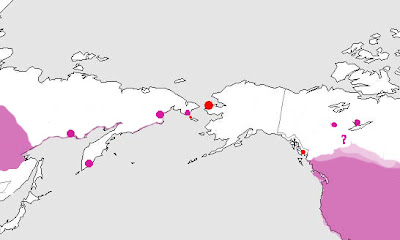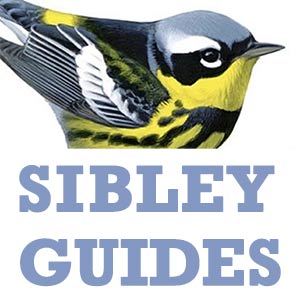[Major updates 25 Feb 2008, adding new information about the introduced Siberian populations]
You might think that the words “intriguing” and “House Sparrow sightings” are mutually exclusive, but here’s a case where they go together! In October 2007 a flock of five House Sparrows showed up in the coastal village of Shishmaref in northwest Alaska. They were found and photographed by science teacher Ken Stenek, as you can read on his website here. Two males were still present as of mid-Feb 2008, demonstrating how hardy this species can be.
House Sparrow is a very rare visitor anywhere in Alaska, with only a few records in the state. Interestingly, one of the few prior Alaska records comes from Gambell, on St Lawrence Island, in mid-summer about 15 years ago. So the question is whether these birds, at the very western edge of Alaska, came from North America or Asia. North American birds originate from multiple introductions in the eastern states in the 1800s. They spread rapidly but they have not spread beyond southern NWT. In fact, in recent decades the species has been declining across most of its world range.
In contrast to the widespread declines in the developed world, House Sparrows have been expanding their range in East Asia, although this expansion is apparently man-made, involving deliberate transplants and releases of House Sparrows in Siberian cities (fide Dan Gibson). The spread of House Sparrows across North America was “accelerated” in the same way a century ago, and the success of the birds must also depend on development and human land-use changes and possibly also warming climate in recent decades. They are now apparently established in a number of settlements along the Russian coast of the Bering Sea at least as far east as Anadyr (Paul Lehman, Dan Gibson), and it would be very interesting to know whether or not these populations are increasing.
 Above is an updated map (25 Feb 2008) of the current range of House Sparrow around Alaska (comments welcome). Shishmaref is indicated by the large red dot. Smaller red dots show Ketchikan in southeast Alaska where there have been five records of House Sparrow, two of those records involve pairs (fide Steve Heinl), and Gambell, on Saint Lawrence Island, where a single House Sparrow was found in summer 1993. Purple dots in Siberia show cities where House Sparrows are known to have been introduced – Magadan, Kamchatskiy, Anadyr, and Providenya (fide Dan Gibson), and presumably they have also been released in other cities and towns.
Above is an updated map (25 Feb 2008) of the current range of House Sparrow around Alaska (comments welcome). Shishmaref is indicated by the large red dot. Smaller red dots show Ketchikan in southeast Alaska where there have been five records of House Sparrow, two of those records involve pairs (fide Steve Heinl), and Gambell, on Saint Lawrence Island, where a single House Sparrow was found in summer 1993. Purple dots in Siberia show cities where House Sparrows are known to have been introduced – Magadan, Kamchatskiy, Anadyr, and Providenya (fide Dan Gibson), and presumably they have also been released in other cities and towns.
In North America the nearest population of House Sparrows is in southern NWT, about 1500 miles east-southeast of Shishmaref. In Asia the species occurs “naturally” only as close as the west edge of the Sea of Okhotsk, about 2000 miles west-southwest. Introduced populations are found along the coast farther east, including Anadyr, less than 500 miles west of Shishmaref, and Providenya, less than 100 miles from Gambell, where some were apparently released just weeks before the 1993 record at Gambell (fide Dan Gibson). My earlier assumption that these cities had been colonized naturally is apparently incorrect, and I don’t know how healthy those populations are, whether they are increasing or not, or whether any persist in Providenya.
Still, the fact that Asian populations are so much closer argues in favor of an Asian origin for the Shishmaref birds. The water crossing, on the other hand, seems formidable for birds coming from that direction, and makes many people think the birds must have been “assisted” in their trip to Shishmaref.
If House Sparrows were coming to western Alaska from Canada I would expect them to colonize Fairbanks and other interior Alaska cities along the way. (They have not). Maybe these birds came up on a boat, especially given increased shipping traffic with the longer ice-free summers in recent years. If any bird has a chance of being transported by truck, train, or ship, it is the House Sparrow. But then I would expect them to be seen in Juneau, Haines, Anchorage, Fairbanks…, all cities with bustling transportation centers. Why Shishmaref?
The answer to the question of origin could possibly be found in a careful study of the birds’ plumage, since North American birds must look slightly different from Asian birds, although all involve the nominate subspecies P. d. domesticus. Or perhaps stable isotope analysis of feathers could reveal the birds’ origin. Ultimately, the next decade or so will probably give us the answer. If House Sparrows are increasing in eastern Siberia and begin to colonize other western Alaska towns (without appearing in southern Alaska) that will be strong evidence that they are invading from the west.
For now it’s a very intriguing House Sparrow sighting, potentially adding a new species to the list of naturally-occurring birds in North America.
Notes:

details of North American distribution from Audubon Christmas Bird Count data
Anderson, T. R. 2006. Biology of the Ubiquitous House Sparrow: from Genes to Populations. Oxford Univ. Press. available online here


Interesting article David – it seems that House Sparrows have the ability to adapt to nearly any habitat. I once heard of a pair living deep in a cool mine where miners were working. The miners threw them bread crumbs and the birds survived for quite a while down there.
I personally dislike these birds. I attend Martin and Bluebird houses and they are more worrisome to these birds than any other predator I have had to deal with. I use a variety of passive and aggressive actions to control these birds when necessary. If I’m not mistaking, House Sparrows are not a federally protected songbird.
Now House Sparrows are really intriguing!! Good job with your blog; I love all these things about rarities in America; although I am from Spain…
I’ll keep visiting your blog looking for news!
Thanks for the comments. Yes, House Sparrows are amazing birds, and one of the few species that really bridges the gap between the human world and the natural world. I’ve seen them in lots of indoor habitats like supermarkets, mall food courts, airport terminals, etc. Unfortunately that makes them “common” (as in “vulgar”) and on top of that they have the bad habit of outcompeting some native cavity-nesters for homes, so they earn a bad reputation.
It is true that they are not protected by federal laws – because they are not native. At some level that distinction seems unfair to me. They’ve been here for over a hundred years, and the habitat they occupy is almost entirely non-native (farms, feedlots, city parks, etc), so what do we expect?
Hi David,
Just want to let you know that I meant to write “coal mine” not “cool mine”, as my comment read.
Alan
Thanks for this post. This is fascinating, particularly since House Sparrows seem to be declining over so much of their range.
Very interesting article. Thanks for the post.
Here in Germany the House Sparrow has been decliding during the last years because of chances in the way houses are built and probably also because of pesticides.
I often refer to these as my House Sparrows and wish they could be wild but am starting to think otherwise. After doing some reading, I think the flight between communities alone would be something that these birds wouldn’t do. I believe these may have hitched a ride on a barge that came up when the Army Corp of Engineers extended a portion of the sea wall. The group of House Sparrows may have hitched a ride inside one of the many van boxes that the construction crew brought along.